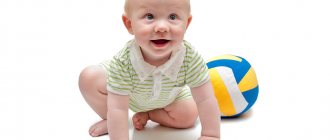Speech development from the first month
“He’s still such a baby, what’s the point!” - you say. However, from the moment of birth, your child is actively trying to express himself with his cry. In the first month of life, he communicates with his parents mainly by crying. For example, the cry of a hungry baby differs in intonation and sounds from the cry of a child who is cold or whose tummy hurts.
Of course, the newborn does not yet understand the meaning of the words, but he is already actively listening to the intonation of what is said. In the third week of life, the baby is already concentrating on the adult’s speech, and it is very important for him to hear quiet, soothing words addressed to him.
Child speech development at 6-10 months
At this time, a healthy baby begins to crawl, and the development of speech is marked by the so-called babbling speech - the first syllables: “Ba-ba”, “cha-cha”, etc. Babbling speech can be reflected - that is, the child repeats what he hears after those around him - and independent: the child invents sounds and is delighted with his own capabilities.
Is there something wrong? Some therapeutic measures should be taken in the following cases:
- if after six months babbling speech does not appear or it is limited to a couple of syllables;
- if the child does not repeat syllables after adults, does not try to repeat the actions of the parents (for example, shake the rattle);
- does not respond to simple commands: “Look, where is the dog?”
What factors influence the appearance of a child’s speech?
- Calm, targeted communication
In the first months of life, the baby actively learns to understand the world. The affectionate intonations heard from his mother allow him to quickly adapt to an unfamiliar environment. Talk to your baby as often as possible while leaning over his crib. Let him see your face and realize that you are calm and cheerful. It is important that the baby hears not only the conversations that adults have among themselves, but also the speech addressed directly to him.
- No unnecessary noise
Try not to turn on music or TV in the background while you are talking with your child. At first, it will be difficult for him to distinguish your speech against the background of extraneous sounds, and extraneous sounds will interfere with the awareness that his mother is communicating with him.
- Development of tactile sensations
Touch is one of the main tools for understanding the world. Give your baby toys and rattles made of different materials more often, let him get acquainted with different textures, shapes and properties of objects. By interacting with various materials, the child will learn to express his emotions regarding what is pleasant to touch and what is not so pleasant. The main thing is to stay safe.
- Facial expressions, gestures
Even as adults, we can convey a significant part of emotions and sensations through facial expressions. Feel free to grimace in front of the baby, make funny faces, express surprise, fear, joy. At first the child may look with interest, later he will smile and laugh in response, and then he will learn to repeat after you.
One month before your first birthday
Here it is, adult life: at the end of the first year, the opportunity finally arises to express your thoughts in words. The most important words break through first: “mom” (attracting the parent’s attention), “give”, etc. The vocabulary is still minimal, so one word expresses dozens of concepts: the cry “mom” can express the joy of meeting, the sadness of parting, resentment, and a call to play. So far this is an excellent result: don’t demand more from your baby, let him learn to speak the words he has mastered well and gradually increase his vocabulary.
Is there something wrong? It’s worth thinking about some kind of correction if the first babbling syllables refuse to grow together into words like “mom”, “dad”, etc.
Stages of speech development
The first stage is screaming
With a cry, a person announces his birth. At the level of an unconditioned reflex, screaming helps the child demand satisfaction of his needs. Most often, in newborns, a cry serves as a signal of discomfort: cold, hungry, wet. With the help of a cry, the baby builds his first unique dialogue: you may notice that, having screamed, he calms down for a while, giving his mother the opportunity to respond to the call. By the third month of life, and often earlier, a child’s cry takes on many shades. This could be a dissatisfied grumble, a sharp squeal, a surprised “exclamation” and much more.
With the advent of the next stages in the baby’s speech behavior, the cry does not disappear, but continues to actively develop. Even with the appearance of words in the lexicon, the child continues to use screaming for communication for a long time.
Second stage - humming
From about 2 to 3 months and up to six months, a period of humming begins in a baby’s life. He pronounces a fantastic, unique set of sounds, singing them in a drawn-out, melodious manner. Walking cannot be confused with anything. Children all over the world walk the same way.
Formation of grammatical structure of speech in preschool children
It is during this period, especially at the age of 3–4 months, that the baby not only actively communicates with you, but also experiences a special need for emotional feedback from an adult. He is so drawn to you, telling you something in his own language, but without receiving a response, this impulse may subside. Children who were isolated from their parents for any reason at this age often experienced delayed speech development in the future.
Look at your baby, build a dialogue with him. At this time, the child is already learning to connect voice and gaze, which in the future becomes the basis for successful communication. You can talk to your child in his language, and you will see how he will reach out to you. Gradually, the combinations of sounds that the baby will produce will become more interesting and longer.
Third stage - babbling
From 6 to 10 months, the child’s speech is more like babbling. It is at this time that the first syllables appear, the makings of future words - “ma”, “ba”, “pa”. At first, they seem to accidentally slip among the sounds made by the baby, but over time they form chains: “ma-ma”, “pa-pa-pa”.
In order for babbling to develop more actively at this stage, constantly talk to your baby, read nursery rhymes and rhythmic rhymes to him. Pronounce the syllables so that the child can see how you do it. Carefully stretch out the sounds, fold your lips into a tube, use all the possibilities of articulation so that the baby has a desire to imitate you.
At this stage, around the tenth month of life, the child begins to associate words with specific objects or actions.
Stage four - first words
After 10 months, the establishment of a relationship between a word and an object occurs more firmly and consciously. The first, most important and necessary words for the child at this stage appear. For example, the first words may be “mom”, “dad”, “give” and others. The vocabulary is still small, and one word in a baby’s vocabulary can take on dozens of meanings.
It is important to help the child in his desire to learn new words. Talk to your child more often, while using the correct concepts for all surrounding things and phenomena.
Children very often strive to repeat the sounds of “talking” toys. At this age, the baby often associates an object, person or animal with the sounds it makes. So, through the mouth of a baby, a cat turns into “meow”, a steam locomotive turns into “choo-choo”, a car will first become a “beep”. You should not treat this children's language with disdain, trying to immediately teach your child the names of objects. This is an inevitable stage of development - the time will come, and “aw-aw” in the voice of your child will definitely turn into a dog.
From birth to 6 months: a variety of sounds
Intonations in infant “speech” appear in the first month of life. They say that only a mother can understand when a child cries from hunger and when from fatigue. In fact, these different types of expression of emotions already have intonation - a “hungry” cry is objectively different from a cry like “my stomach hurts.”
The second month is the time when the facial components of communication are connected: the child begins to smile with joy, raise his eyebrows in surprise... The whole body takes part in the expression of emotions: arms and legs also actively signal experiences!
Third-fourth months: humming appears. This is a fantastic set of alien sounds that cannot be confused with anything else: it contains sounds from all the languages of the world. In the literal sense of the word: all over the world, children walk the same way.
Along with the revelry, a powerful surge of emotional communication occurs: an indomitable interest in the world around us and interaction breaks through. And at this moment it is important to provide the child with a response: mutual interest. If this does not happen, the ability of self-expression and productive communication gradually fades (what is not in demand does not develop). That is why a child who, due to illness or an unfavorable situation in the family, was isolated from his parents at 3-4 months of life, subsequently faces delayed emotional and personal development and speech disorders.
Is there something wrong? Here is a list of alarm bells, if you notice them, there is a reason to contact a specialist:
- the child does not intonate: the crying is monotonous, and even a sensitive mother is unable to understand what he “wants to say”;
- before crying, the child does not grunt: normally he should “accelerate”, tune in to crying - and only then scream;
- monotonous humming - repetition of the same sound patterns;
- the child does not smile or laugh, does not react to the emotionally charged speech of others.
Please note that any described disorders are not a reason to make a particular diagnosis. Perhaps this is a temporary phenomenon. It’s very possible that it just seemed to you: the mother is tired, and is unable to understand what the baby is screaming and lamenting about at the moment. However, it is equally likely that this is a signal of a possible pathology. Therefore, if suspicion grows, there is a reason to contact a specialist (we will discuss who exactly below).
Some age norms
- 1 month. The baby knows how to focus attention on the adult’s voice.
- 2 months. A parent's voice can calm a crying baby.
- 3 months. The baby may respond to conversations with sounds or laughter.
- 4 months. Humming is actively developing, the baby can make sounds even when the parents are far away.
- 5 – 6 months. At this time, the baby can already address his communication to a specific person, but for now he reacts even more actively to gestures rather than to words.
- 7 – 8 months. The child can already turn to the object if asked, for example: “Where is the car?” However, the connection is still unstable, and if the machine is in an unusual place, the baby may not find it. The child can often sit down, stand up, or wave his hand at the request of an adult.
- 10 months. The baby can find several familiar objects if they are swapped.
- 11 months. Can give mom almost any toy she asks for. Reacts well to words, calls, even those not accompanied by gestures.
- 12 months. New words appear in the lexicon, their stock is gradually expanding. The baby associates them well with objects, but can use one word to name several phenomena or things.
The use of mnemonics in the development of speech in preschool children
Remember that your child is an individual, and he is not obliged to develop strictly according to prescribed standards within a certain time frame. However, you should pay attention if your baby:
- in the first six months he cries constantly the same way, the cause of the crying cannot be distinguished;
- up to 6 months does not respond to emotional speech from adults;
- after 6 months, does not seek to repeat individual syllables and actions after the mother;
- after 10 months does not respond to simple requests;
- by one year does not try to put individual syllables into words (for example, “mom”).
These phenomena do not necessarily serve as a signal of any pathology, however, if you notice many alarming “bells”, this is a reason to share your observations with your doctor so that he can dispel your fears and doubts.
What does a 9 month old baby understand?
If you have worked with your child and learned some movements with him in the previous months, such as clapping your hands or waving a hand, the child is aware of the meaning of these words. Therefore, to perform a familiar movement, it will be enough to ask the child to do it without using special gestures.
The child is aware of other simple requests; “Give mommy the bunny.” But this is possible if at this time the child looks at the bunny and the mother confirms her request with a gesture - she extends her hand to the bunny. The baby will be able to truly understand speech in 2-3 months.
If you say the child's name, he will respond quickly. He will not respond to someone else's name or will look for the one who was named. If you ask a child: “Where is the bunny?”, “Where is the kitty?”, he can find the named object, and it does not matter where this thing is located.
If the toy is familiar to the child, he may find it in a pile of other toys and hand it to you. The baby begins to realize the prohibition. Of course, he doesn’t notice it yet, but you can observe a slight braking reaction when hearing the words “no” and “no.”
How to choose a speech therapist
The speech therapist needs to establish a trusting relationship with the child. Only by establishing good contact with the baby will the speech therapist be able to correct deviations in speech development.
If a child does not open up to a specialist for a long time, you have to admit that this specialist is not suitable for you. Moreover, in such a situation, most often there is no one to blame: this is not a “beech” child or an illiterate specialist - it’s just that for some reason the child and the adult did not coincide. This happens, and in this case you will have to look for another speech therapist.
What to expect from speech therapy sessions? A competent and friendly approach to your child, receiving answers to all your questions, selecting an individual development program, correction and restoration of speech functions.
Article provided by OsteoPolyClinic
Speech development from 4 to 5 years. If the child speaks poorly
In the speech of a child aged 4 to 5 years, the pronunciation aspect of speech improves: the child speaks the following sounds correctly - [w], [zh], [sch], [h], [ts], “difficult” letters L and R appear; Monologue speech is actively developing. In the speech of children under 5 years old, the absence of the sounds [r] and [r'], sometimes [l], is possible; errors in complex grammatical constructions are possible; the baby may confuse cases or incorrectly place stress in a word. But mistakes should not be frequent.
If you notice that disturbances in your child’s speech are continuous, he speaks poorly, contact a speech therapist.
At this age
- the child must speak correctly, without softening the sounds (“sledge”, not “syanki”, “apple”, not “yabloko”);
- sounds [k], [g], [v], [f], [s] are pronounced correctly,
- speech contains sounds [l], [sh], [zh], [r]
If by the age of 4.5 years speech development does not correspond to the given norm, classes with a speech therapist are needed.
Sometimes children start talking quite late (4 years - 5 years). In such situations, many speech defects may appear. If this is your case, do not delay your visit to a speech therapist - your pronunciation must be corrected in time.
Speech development from 2 to 3 years. If the child is non-verbal
From the age of two, the child gradually masters the grammatical forms of his native language. By approximately 2.5 years, nouns in the accusative, prepositional, and dative cases appear in speech. By 2-2.5 years, the child speaks simple phrases (of two or three words), such as “Papa tutu” - dad left, or “what a bibi” — open the car. By this age the child should:
- It is good to understand the speech addressed to him;
- Retain in memory and follow two-step instructions, such as “take the ball and take it to dad”;
- Strive for verbal contact, make requests;
- The child's speech should be accompanied by gestures











